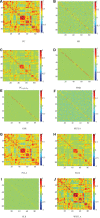Constructing Dynamic Functional Networks via Weighted Regularization and Tensor Low-Rank Approximation for Early Mild Cognitive Impairment Classification
- PMID: 33505965
- PMCID: PMC7829545
- DOI: 10.3389/fcell.2020.610569
Constructing Dynamic Functional Networks via Weighted Regularization and Tensor Low-Rank Approximation for Early Mild Cognitive Impairment Classification
Abstract
Brain functional networks constructed via regularization has been widely used in early mild cognitive impairment (eMCI) classification. However, few methods can properly reflect the similarities and differences of functional connections among different people. Most methods ignore some topological attributes, such as connection strength, which may delete strong functional connections in brain functional networks. To overcome these limitations, we propose a novel method to construct dynamic functional networks (DFN) based on weighted regularization (WR) and tensor low-rank approximation (TLA), and apply it to identify eMCI subjects from normal subjects. First, we introduce the WR term into the DFN construction and obtain WR-based DFNs (WRDFN). Then, we combine the WRDFNs of all subjects into a third-order tensor for TLA processing, and obtain the DFN based on WR and TLA (WRTDFN) of each subject in the tensor. We calculate the weighted-graph local clustering coefficient of each region in each WRTDFN as the effective feature, and use the t-test for feature selection. Finally, we train a linear support vector machine (SVM) classifier to classify the WRTDFNs of all subjects. Experimental results demonstrate that the proposed method can obtain DFNs with the scale-free property, and that the classification accuracy (ACC), the sensitivity (SEN), the specificity (SPE), and the area under curve (AUC) reach 87.0662% ± 0.3202%, 83.4363% ± 0.5076%, 90.6961% ± 0.3250% and 0.9431 ± 0.0023, respectively. We also achieve the best classification results compared with other comparable methods. This work can effectively improve the classification performance of DFNs constructed by existing methods for eMCI and has certain reference value for the early diagnosis of Alzheimer's disease (AD).
Keywords: classification; dynamic functional network (DFN); early mild cognitive impairment (eMCI); tensor low-rank approximation (TLA); weighted regularization (WR).
Copyright © 2021 Jiao, Ji, Zhang, Shi and Wang.
Conflict of interest statement
The authors declare that the research was conducted in the absence of any commercial or financial relationships that could be construed as a potential conflict of interest.
Figures






Similar articles
-
Constructing Dynamic Brain Functional Networks via Hyper-Graph Manifold Regularization for Mild Cognitive Impairment Classification.Front Neurosci. 2021 Apr 1;15:669345. doi: 10.3389/fnins.2021.669345. eCollection 2021. Front Neurosci. 2021. PMID: 33867931 Free PMC article.
-
Classification of Early and Late Mild Cognitive Impairment Using Functional Brain Network of Resting-State fMRI.Front Psychiatry. 2019 Aug 27;10:572. doi: 10.3389/fpsyt.2019.00572. eCollection 2019. Front Psychiatry. 2019. PMID: 31555157 Free PMC article.
-
Integrating the Local Property and Topological Structure in the Minimum Spanning Tree Brain Functional Network for Classification of Early Mild Cognitive Impairment.Front Neurosci. 2018 Oct 8;12:701. doi: 10.3389/fnins.2018.00701. eCollection 2018. Front Neurosci. 2018. PMID: 30349451 Free PMC article.
-
Feature Selection and Combination of Information in the Functional Brain Connectome for Discrimination of Mild Cognitive Impairment and Analyses of Altered Brain Patterns.Front Aging Neurosci. 2020 Feb 19;12:28. doi: 10.3389/fnagi.2020.00028. eCollection 2020. Front Aging Neurosci. 2020. PMID: 32140102 Free PMC article.
-
Classification of Alzheimer's Disease, Mild Cognitive Impairment, and Normal Controls With Subnetwork Selection and Graph Kernel Principal Component Analysis Based on Minimum Spanning Tree Brain Functional Network.Front Comput Neurosci. 2018 May 9;12:31. doi: 10.3389/fncom.2018.00031. eCollection 2018. Front Comput Neurosci. 2018. PMID: 29867424 Free PMC article.
Cited by
-
GWLS: A Novel Model for Predicting Cognitive Function Scores in Patients With End-Stage Renal Disease.Front Aging Neurosci. 2022 Feb 3;14:834331. doi: 10.3389/fnagi.2022.834331. eCollection 2022. Front Aging Neurosci. 2022. PMID: 35185530 Free PMC article.
-
Integration and Segregation of Dynamic Functional Connectivity States for Mild Cognitive Impairment Revealed by Graph Theory Indicators.Contrast Media Mol Imaging. 2021 Jul 17;2021:6890024. doi: 10.1155/2021/6890024. eCollection 2021. Contrast Media Mol Imaging. 2021. PMID: 34366726 Free PMC article.
-
Characterizing Topological Properties of Brain Functional Networks Using Multi-Threshold Derivative for End-Stage Renal Disease with Mild Cognitive Impairment.Brain Sci. 2023 Aug 10;13(8):1187. doi: 10.3390/brainsci13081187. Brain Sci. 2023. PMID: 37626543 Free PMC article.
-
Constructing Dynamic Brain Functional Networks via Hyper-Graph Manifold Regularization for Mild Cognitive Impairment Classification.Front Neurosci. 2021 Apr 1;15:669345. doi: 10.3389/fnins.2021.669345. eCollection 2021. Front Neurosci. 2021. PMID: 33867931 Free PMC article.
-
BCNet: A Novel Network for Blood Cell Classification.Front Cell Dev Biol. 2022 Jan 3;9:813996. doi: 10.3389/fcell.2021.813996. eCollection 2021. Front Cell Dev Biol. 2022. Retraction in: Front Cell Dev Biol. 2024 Jan 05;11:1358376. doi: 10.3389/fcell.2023.1358376. PMID: 35047515 Free PMC article. Retracted.
References
-
- Atangana A., Liu A. J., Lu Z. Y. (2018). Application of stationary Wavelet entropy in pathological brain detection. Multimed. Tools Applic. 77 3701–3714. 10.1007/s11042-016-3401-7 - DOI
-
- Chang C. C., Lin C. J. L. I. B. S. V. M. (2011). A library for support vector machines. ACM Transact. Int. Syst. Technol. 2 389–396.
LinkOut - more resources
Full Text Sources
Other Literature Sources

